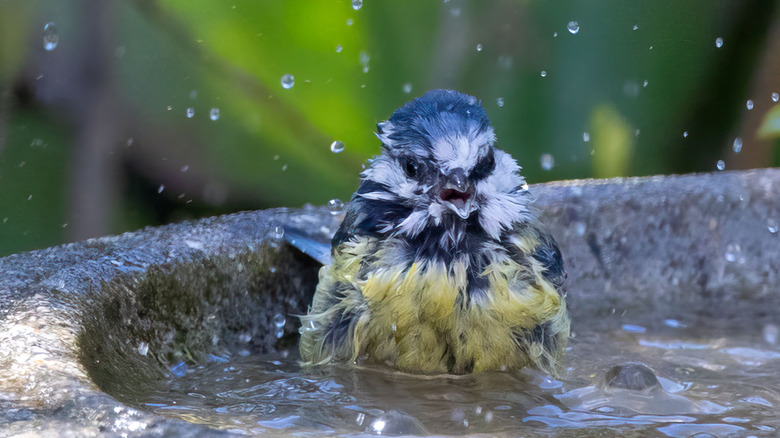Hate Messy Seeds? Discover The Much Simpler Way To Get Birds In Your Yard
A backyard buffet for birds is a lovely way to observe and enjoy them. More importantly, it also gives the visitors a boost to help them through lean times. But those seeds can create a major mess, and keeping the feeders full can feel like a Sisyphean task. Bird-loving homeowners in the U.S. spend roughly $4 billion annually on seed and feeders, only to watch much of it scattered on the ground. It's also easy to forget how essential water is for all animals. Along with bird feeder alternatives that naturally attract birds to your yard, a birdbath is a much cheaper — and arguably more helpful — way to do this. These containers are hardly revolutionary, but people tend to underestimate their importance.
Not every feathered visitor eats seeds, but you can be sure that every one of them needs water to both drink and bathe. Ideally, it should provide fresh, clean water in a spot where birds are safe from predators. Some other nice touches that make the baths even better are places for perching and a feature that adds movement to the water.
There are tons of ways to make a charming DIY birdbath, many of which involve repurposing items that would otherwise become garbage. But there are a few design features to keep in mind when shopping or upcycling. Don't choose a bath that's too deep; one with graduated sides lets birds wade in without a sudden plunge into the water. Glazed ceramic can be slippery, and concrete can be difficult to clean. Plastic or metal baths with gently sloping sides are good choices.
Care for your birdbath to keep birds safe
Once you've picked out the right kind of bath, deciding where to put it and keeping it clean and filled are the next considerations. The wrong type of care could actually hurt birds. While setting a bath on the ground mimics how birds bathe in nature, placing your bird bath on a raised surface gives them a bit more protection from predators. Without regularly cleaning the bath and changing the water, a bird bath can harbor diseases like avian pox, salmonellosis, and conjunctivitis. Prevent this by changing the water daily and washing out any debris. Fully disinfect the bath once or twice a month, as well, making sure to rinse away all traces of disinfectant before refilling it.
On days when the temperatures plummet, take extra care that the birds can drink but not get fully wet. There have been cases of birds bathing when outside temperatures are below freezing and having their feathers freeze. This can prevent them from flying and even cause feathers to freeze to nearby surfaces. This occurs mainly in heated baths. Drippers or water wigglers that keep the water moving in any bath can slow the water's freezing process in any bath. However, moving water can still allow splashy bathing in cold weather.
Help birds access drinking water in winter by limiting the risk of them soaking their feathers. A piece of hardware cloth or a grill rack set on top of the bath will allow the birds to perch without getting wet. They can reach through the openings for a refreshing drink while staying dry. With the simple addition of fresh water, your yard can become a favorite stop for birds all year long, without the messy seed litter.

